Key Takeaways
- After accounting for inflation, Tennesseans’ 2023 median household income remained relatively unchanged, while the poverty rate grew.
- Compared to white Tennesseans, the difference in poverty rates shrank for both black and Hispanic Tennesseans between 2010 and 2023, but the income gap narrowed only for Hispanics.
The U.S. Census Bureau released new data in September 2024 on income, poverty, education, and health insurance coverage from 2023. These metrics paint a picture of the social and economic circumstances across America. Here’s what stands out from Tennessee’s 2023 income and poverty estimates.[1]
Income and Poverty in Tennessee
After accounting for inflation, Tennesseans’ 2023 median household income remained relatively unchanged, while the poverty rate grew. Tennessee’s median household income reached $67,631 last year, meaning half of households had less income and half had more (Figure 1). (1) After adjusting for inflation, this amount was not statistically significantly different from the 2022 amount (Figure 2). (1) Compared to 2022, official poverty rates rose 0.7 percentage points to 14.0% among all Tennesseans and 2.1 percentage points to 19.7% among children (Figure 3). (1)
Tennessee has higher poverty rates and lower income levels than the U.S., but those gaps narrowed over the last decade. In 2010, the official poverty rate was 2.4 percentage points higher in Tennessee than nationwide, and the child poverty rate was 4.1 points higher. In 2023, those gaps had narrowed to 1.5 and 3.7 points, respectively (Figure 4). Meanwhile, Tennessee’s median household income in 2010 was about $12,000 lower than the national amount after adjusting for inflation and narrowed to about $10,000 in 2023.
Figure 1
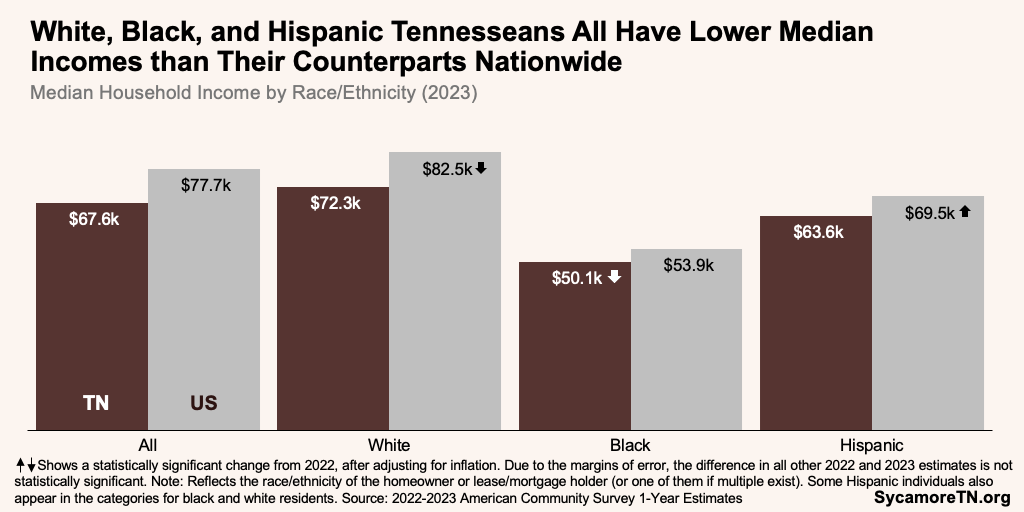
Figure 2
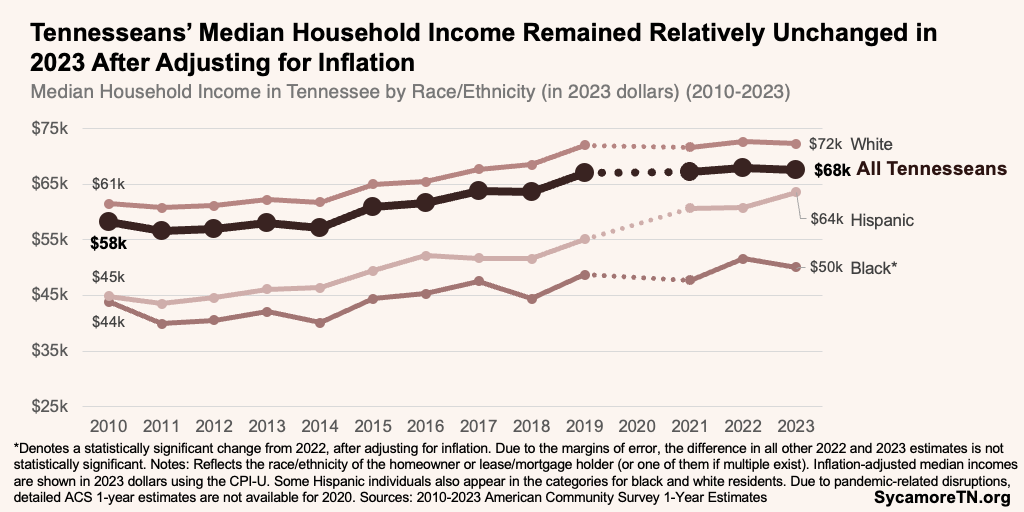
Figure 3
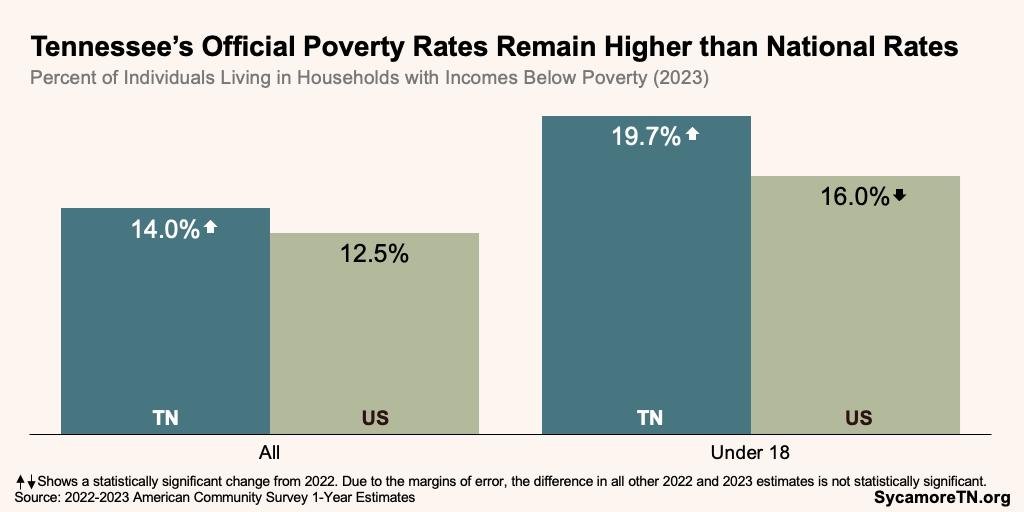
Figure 4
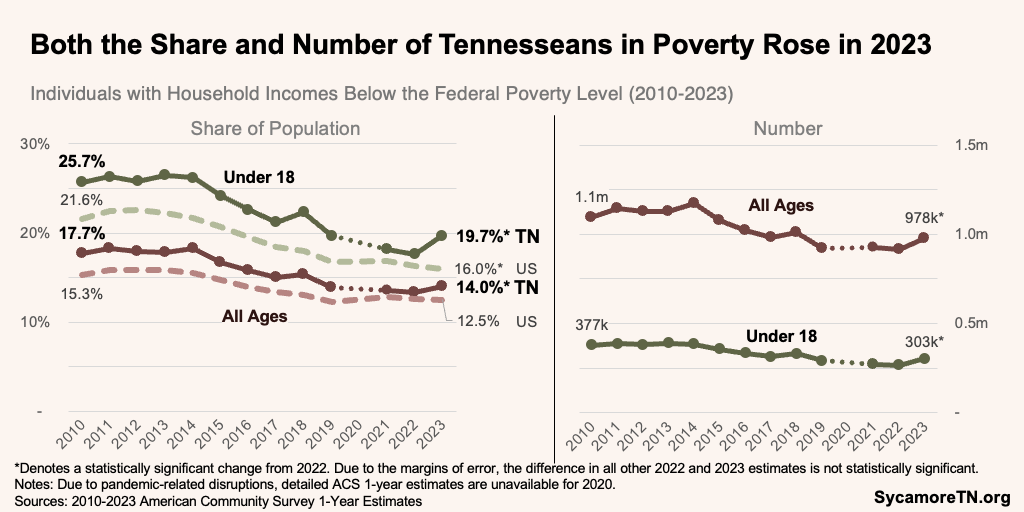
Demographic Variation
Tennessee’s poverty rate and median income vary across race, ethnicity, education level, employment, and household type. In 2023, black Tennesseans, adults without a high school diploma, and unemployed adults had the highest poverty rates. White residents, college graduates, and full-time workers had the lowest (Figure 5). Across household types, poverty rates were lowest for married couples without children and highest for households headed by an unmarried mother (Figure 6). The poverty rate grew for white Tennesseans, every type of married household, and single mother households. It shrank slightly for female-headed households without children. (1)
Figure 5
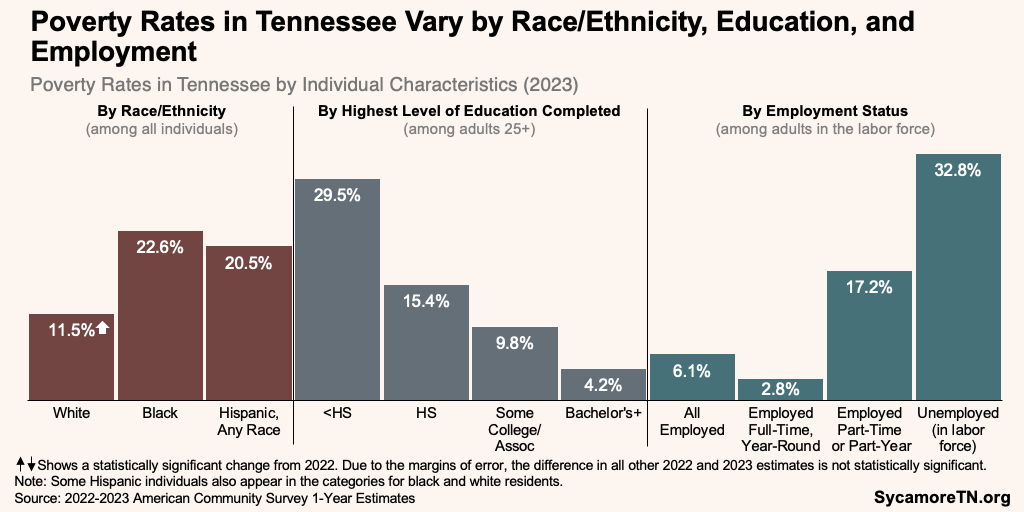
Figure 6
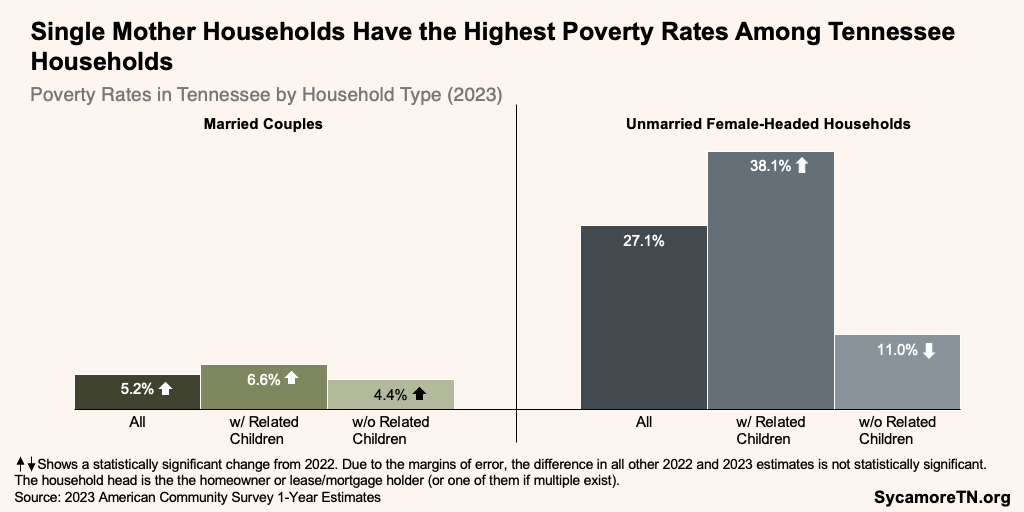
Compared to white Tennesseans, the difference in poverty rates shrank for both black and Hispanic Tennesseans between 2010 and 2023, but the income gap narrowed only for Hispanics (Figures 2 and 7). (1) During that time, the difference in poverty rates in Hispanic and white Tennesseans fell from 19 percentage points to 9. Meanwhile, the gap between black and white Tennesseans shrank from 14 points to 11. In 2010, the median income of Hispanic households was about $16,600 less than white households after adjusting for inflation. This difference had shrunk to about $8,800 by 2023. However, the difference for black households grew from about $17,600 to $22,300.
Figure 7
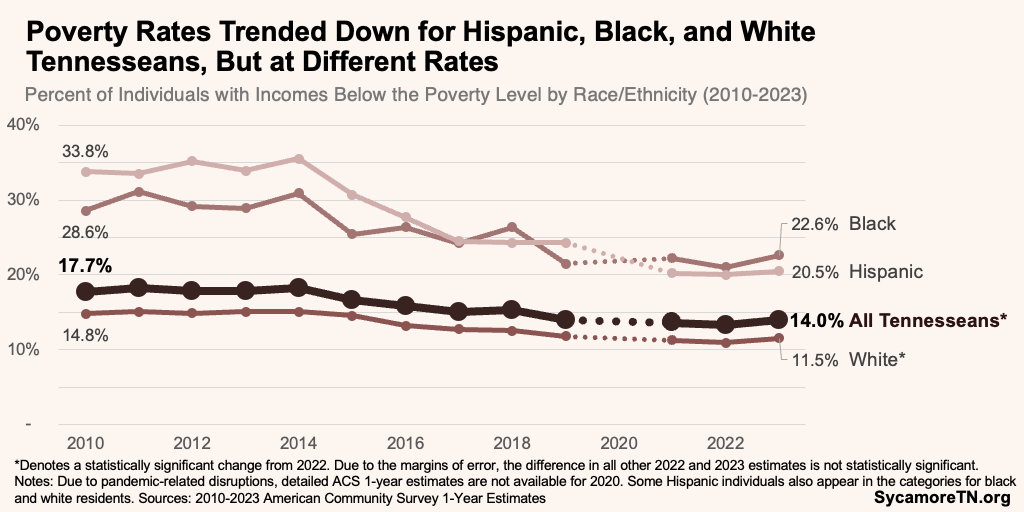
Geographic Variation
Income and poverty rates vary by geography in Tennessee. The Census Bureau’s September 2023 data release includes 2023 estimates for counties over 65,000 people. (1) Among the 21 Tennessee counties with available data:
- Median Household Income — Median household income ranged from over $133,000 in Williamson County to about $53,200 in Hamblen County (Figure 8). After adjusting for inflation, three counties experienced a statistically significant income change between 2022 and 2023. Due to the margins of error, the changes for the other 18 counties are not statistically significant.
- Poverty Rate — The official poverty rate varied from 5.5% in Wilson County to 20.6% in Hamblen County (Figure 9). From 2022 to 2023, statistically significant changes occurred in Davidson (down 2.3 points), Knox (up 2.5 points), and Madison (up 7.0 points).
- Child Poverty — Meanwhile, the poverty rate among residents younger than 18 ranged from 7.6% in Williamson County to 34.7% in Madison County (Figure 10). Statistically significant changes occurred in 5 counties—Davidson (down 6.0 points), Knox (up 6.9 points), Madison (up 19.5 points), Sumner (up 8.4 points), and Williamson (up 4.2 points).
See Table A1 in the Appendix for county-specific data for 2022-2023.
Figure 8
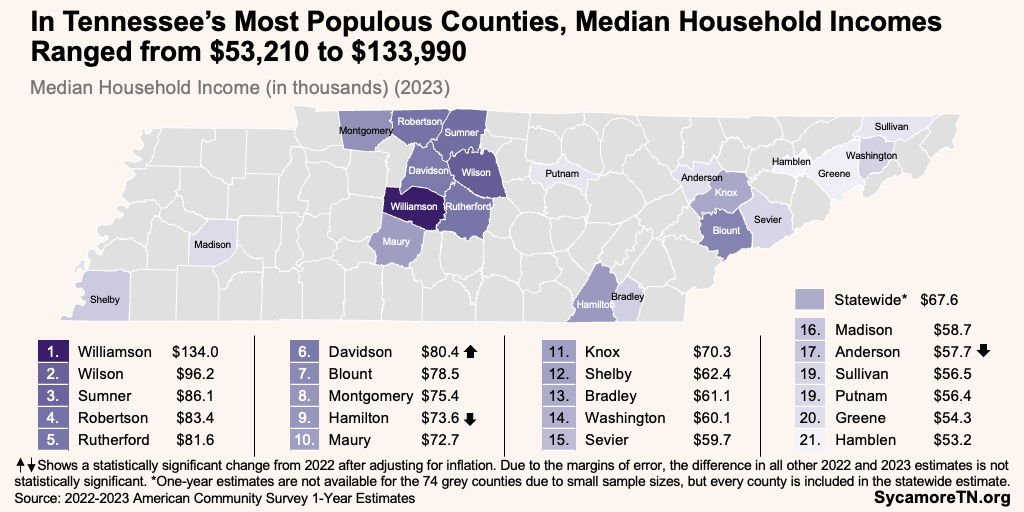
Figure 9
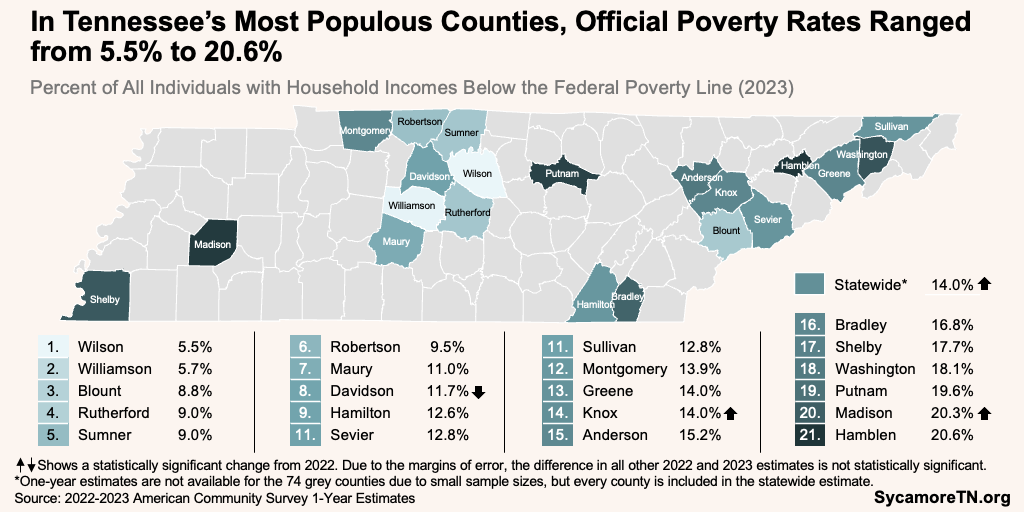
Figure 10
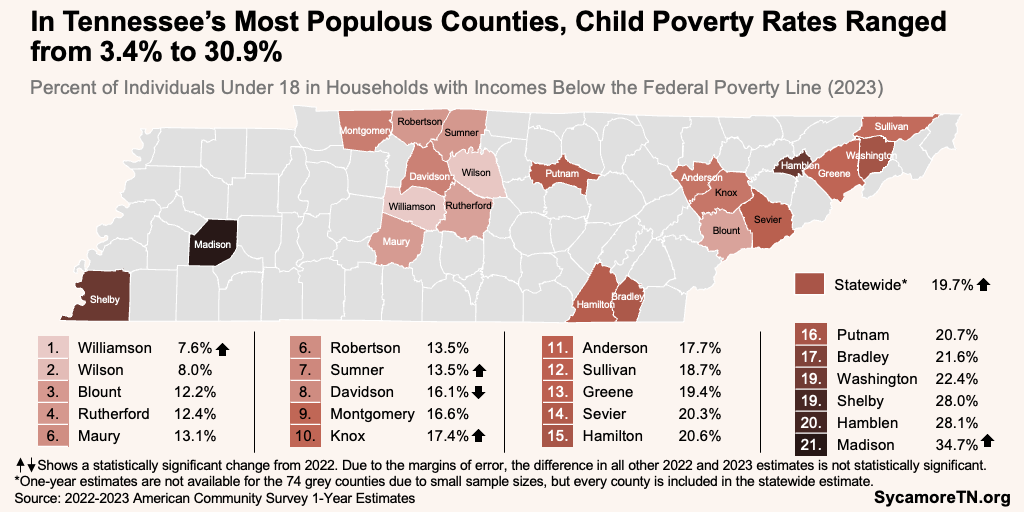
References
Click to Open/Close
References
- U.S. Census Bureau. 2010-2023 American Community Survey 1-Year Estimates. [Online] September 2024. Available via http://data.census.gov. Some data are also available from KIDS COUNT Data Center via https://datacenter.aecf.org/.
[1] Due to the margins of error, the difference in some 2022 and 2023 estimates is not statistically significant. The Census Bureau’s American Community Survey generates estimates based on a sample of the total population. The margin of error measures the likely range of the true value if every person were surveyed. When the error margins for two values overlap, the difference may simply be due to sampling or estimation issues. To learn more about the importance of samples, read our tips for interpreting statistics.

